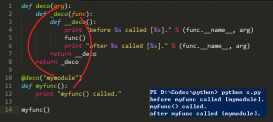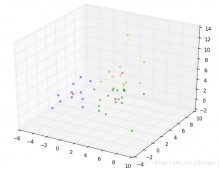我就废话不多说了,直接上代码吧!
|
1
2
3
4
5
6
7
8
9
10
11
12
13
14
15
16
17
18
19
20
21
22
23
24
25
26
27
28
29
30
31
32
33
34
35
36
37
38
39
40
41
42
43
44
45
46
47
48
49
50
51
52
53
54
55
56
57
58
59
60
61
62
63
64
65
66
67
68
69
70
71
72
73
74
75
76
77
78
79
80
81
82
83
84
85
86
87
88
89
90
91
92
93
94
95
96
97
98
99
100
101
102
103
104
105
106
107
108
109
110
111
112
113
114
115
116
117
118
119
120
121
122
123
124
125
126
127
128
129
130
131
132
133
134
135
136
137
138
139
140
141
142
143
144
145
146
147
148
149
150
151
152
153
154
155
156
157
158
159
160
161
162
163
164
165
166
167
168
169
170
171
|
# -*- coding: utf-8 -*-"""Created on Sat Oct 13 10:22:45 2018@author: www""" import torchfrom torch import nnfrom torch.autograd import Variable import torchvision.transforms as tfsfrom torch.utils.data import DataLoader, samplerfrom torchvision.datasets import MNIST import numpy as np import matplotlib.pyplot as pltimport matplotlib.gridspec as gridspec plt.rcParams['figure.figsize'] = (10.0, 8.0) # 设置画图的尺寸plt.rcParams['image.interpolation'] = 'nearest'plt.rcParams['image.cmap'] = 'gray' def show_images(images): # 定义画图工具 images = np.reshape(images, [images.shape[0], -1]) sqrtn = int(np.ceil(np.sqrt(images.shape[0]))) sqrtimg = int(np.ceil(np.sqrt(images.shape[1]))) fig = plt.figure(figsize=(sqrtn, sqrtn)) gs = gridspec.GridSpec(sqrtn, sqrtn) gs.update(wspace=0.05, hspace=0.05) for i, img in enumerate(images): ax = plt.subplot(gs[i]) plt.axis('off') ax.set_xticklabels([]) ax.set_yticklabels([]) ax.set_aspect('equal') plt.imshow(img.reshape([sqrtimg,sqrtimg])) return def preprocess_img(x): x = tfs.ToTensor()(x) return (x - 0.5) / 0.5 def deprocess_img(x): return (x + 1.0) / 2.0 class ChunkSampler(sampler.Sampler): # 定义一个取样的函数 """Samples elements sequentially from some offset. Arguments: num_samples: # of desired datapoints start: offset where we should start selecting from """ def __init__(self, num_samples, start=0): self.num_samples = num_samples self.start = start def __iter__(self): return iter(range(self.start, self.start + self.num_samples)) def __len__(self): return self.num_samples NUM_TRAIN = 50000NUM_VAL = 5000 NOISE_DIM = 96batch_size = 128 train_set = MNIST('E:/data', train=True, transform=preprocess_img) train_data = DataLoader(train_set, batch_size=batch_size, sampler=ChunkSampler(NUM_TRAIN, 0)) val_set = MNIST('E:/data', train=True, transform=preprocess_img) val_data = DataLoader(val_set, batch_size=batch_size, sampler=ChunkSampler(NUM_VAL, NUM_TRAIN)) imgs = deprocess_img(train_data.__iter__().next()[0].view(batch_size, 784)).numpy().squeeze() # 可视化图片效果show_images(imgs) #判别网络def discriminator(): net = nn.Sequential( nn.Linear(784, 256), nn.LeakyReLU(0.2), nn.Linear(256, 256), nn.LeakyReLU(0.2), nn.Linear(256, 1) ) return net #生成网络def generator(noise_dim=NOISE_DIM): net = nn.Sequential( nn.Linear(noise_dim, 1024), nn.ReLU(True), nn.Linear(1024, 1024), nn.ReLU(True), nn.Linear(1024, 784), nn.Tanh() ) return net #判别器的 loss 就是将真实数据的得分判断为 1,假的数据的得分判断为 0,而生成器的 loss 就是将假的数据判断为 1 bce_loss = nn.BCEWithLogitsLoss()#交叉熵损失函数 def discriminator_loss(logits_real, logits_fake): # 判别器的 loss size = logits_real.shape[0] true_labels = Variable(torch.ones(size, 1)).float() false_labels = Variable(torch.zeros(size, 1)).float() loss = bce_loss(logits_real, true_labels) + bce_loss(logits_fake, false_labels) return loss def generator_loss(logits_fake): # 生成器的 loss size = logits_fake.shape[0] true_labels = Variable(torch.ones(size, 1)).float() loss = bce_loss(logits_fake, true_labels) return loss # 使用 adam 来进行训练,学习率是 3e-4, beta1 是 0.5, beta2 是 0.999def get_optimizer(net): optimizer = torch.optim.Adam(net.parameters(), lr=3e-4, betas=(0.5, 0.999)) return optimizer def train_a_gan(D_net, G_net, D_optimizer, G_optimizer, discriminator_loss, generator_loss, show_every=250, noise_size=96, num_epochs=10): iter_count = 0 for epoch in range(num_epochs): for x, _ in train_data: bs = x.shape[0] # 判别网络 real_data = Variable(x).view(bs, -1) # 真实数据 logits_real = D_net(real_data) # 判别网络得分 sample_noise = (torch.rand(bs, noise_size) - 0.5) / 0.5 # -1 ~ 1 的均匀分布 g_fake_seed = Variable(sample_noise) fake_images = G_net(g_fake_seed) # 生成的假的数据 logits_fake = D_net(fake_images) # 判别网络得分 d_total_error = discriminator_loss(logits_real, logits_fake) # 判别器的 loss D_optimizer.zero_grad() d_total_error.backward() D_optimizer.step() # 优化判别网络 # 生成网络 g_fake_seed = Variable(sample_noise) fake_images = G_net(g_fake_seed) # 生成的假的数据 gen_logits_fake = D_net(fake_images) g_error = generator_loss(gen_logits_fake) # 生成网络的 loss G_optimizer.zero_grad() g_error.backward() G_optimizer.step() # 优化生成网络 if (iter_count % show_every == 0): print('Iter: {}, D: {:.4}, G:{:.4}'.format(iter_count, d_total_error.item(), g_error.item())) imgs_numpy = deprocess_img(fake_images.data.cpu().numpy()) show_images(imgs_numpy[0:16]) plt.show() print() iter_count += 1 D = discriminator()G = generator() D_optim = get_optimizer(D)G_optim = get_optimizer(G) train_a_gan(D, G, D_optim, G_optim, discriminator_loss, generator_loss) |
以上这篇pytorch:实现简单的GAN示例(MNIST数据集)就是小编分享给大家的全部内容了,希望能给大家一个参考,也希望大家多多支持服务器之家。
原文链接:https://blog.csdn.net/xckkcxxck/article/details/83037025












